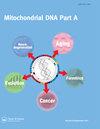MLPA技术检测Leber遗传性视神经病变常见突变的效果
IF 0.6
4区 生物学
Q4 GENETICS & HEREDITY
引用次数: 0
摘要
Leber遗传性视神经病变(LHON)是由线粒体DNA (mtDNA)突变引起的无痛性视力丧失。超过95%的LHON病例源于三种mtDNA点突变之一(m.3460G>A、m.11778G>A和m.14484T>C)。LHON没有确定的治疗方法;早期和准确的诊断将使患者得到适当的治疗,从而减少疾病的进展。为了提高LHON分子基因检测的可及性,需要一种准确且具有成本效益的技术。本研究的目的是评估多重结扎依赖探针扩增(MLPA)检测18例LHON血液标本中三种常见突变的准确性。直接DNA测序技术验证结果证明,MLPA技术具有100%的准确性,无假阳性结果。这项研究表明,MLPA可以为线粒体疾病的常规分子基因检测提供一种高度准确、经济、可广泛使用的技术。本文章由计算机程序翻译,如有差异,请以英文原文为准。
Performance of the MLPA technique for detecting common mutations in Leber hereditary optic neuropathy
Abstract Leber hereditary optic neuropathy (LHON) causes painless vision loss resulting from mitochondrial DNA (mtDNA) mutation. Over 95% of LHON cases result from one of three mtDNA point mutations (m.3460G>A, m.11778G>A, and m.14484T>C). There is no established cure for LHON; early and accurate diagnosis would enable patients to be given appropriate treatments leading to a reduction of the disease progression. To increase the accessibility to molecular genetic testing for LHON, an accurate and cost-effective technique is required. The purpose of this study was to evaluate the accuracy of multiplex ligation-dependent probe amplification (MLPA) for detecting the three common mutations in 18 LHON blood specimens. Validation of the results using direct DNA sequencing technology proved that the MLPA technique had 100% accuracy, with no false-positive results. This study demonstrates that MLPA could provide a highly accurate, economical, and widely accessible technique for routine molecular genetic testing for mitochondrial disorders.
求助全文
通过发布文献求助,成功后即可免费获取论文全文。
去求助
来源期刊

Mitochondrial Dna Part a
Biochemistry, Genetics and Molecular Biology-Genetics
CiteScore
3.00
自引率
0.00%
发文量
6
期刊介绍:
Mitochondrial DNA Part A publishes original high-quality manuscripts on physical, chemical, and biochemical aspects of mtDNA and proteins involved in mtDNA metabolism, and/or interactions. Manuscripts on cytosolic and extracellular mtDNA, and on dysfunction caused by alterations in mtDNA integrity as well as methodological papers detailing novel approaches for mtDNA manipulation in vitro and in vivo are welcome. Descriptive papers on DNA sequences from mitochondrial genomes, and also analytical papers in the areas of population genetics, phylogenetics and human evolution that use mitochondrial DNA as a source of evidence for studies will be considered for publication. The Journal also considers manuscripts that examine population genetic and systematic theory that specifically address the use of mitochondrial DNA sequences, as well as papers that discuss the utility of mitochondrial DNA information in medical studies and in human evolutionary biology.
 求助内容:
求助内容: 应助结果提醒方式:
应助结果提醒方式:


